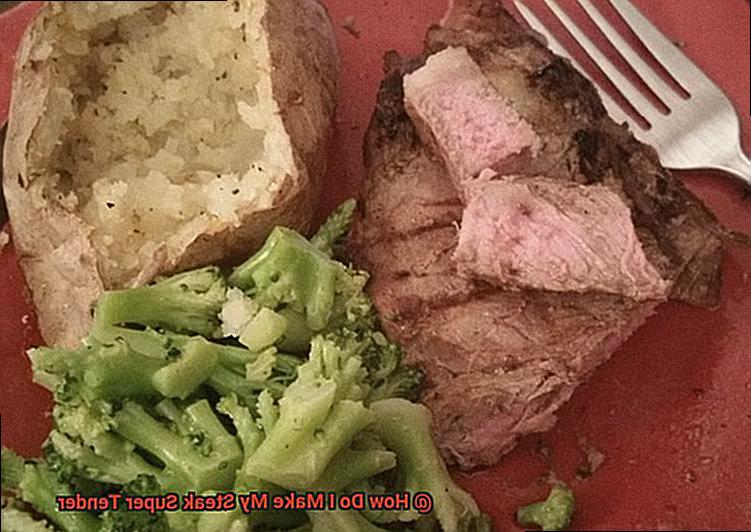Do you ever find yourself struggling to chew through a tough and unappetizing steak? Are you yearning for that juicy, tender meat that simply melts in your mouth with every bite? If so, then you’ve come to the right place.
Creating a steak that is super tender isn’t just about cooking it correctly. There are several techniques and tips that can make all the difference in achieving a perfectly tender steak every time. And let me tell you, once you start using these methods, there’s no going back to those stringy and rubbery cuts of meat.
In this blog post, I’ll be sharing my expert knowledge and experience on how to make your steak super tender. From selecting the perfect cut of meat, to preparing and marinating it, to cooking and resting your steak for ultimate tenderness – I’ve got you covered. You’ll learn the secrets that top-notch chefs around the world use to create exquisite and mouth-watering steaks.
So get ready to elevate your steak game like never before and impress your loved ones with your culinary prowess. Let’s dive right in and discover how to achieve that perfect level of tenderness in every single bite.
Contents
Choosing the Right Cut of Meat
When it comes to selecting the perfect cut, there are several factors to consider, including tenderness, flavor, and cooking method. Cheaper cuts like flank or skirt steak can be tough and chewy if not cooked properly, while more expensive cuts like ribeye, tenderloin, and sirloin tend to be more tender due to their lower connective tissue and fat content.
For those seeking ultimate tenderness, the filet mignon is an excellent choice. This cut comes from the tenderloin and offers a lean texture with a mild flavor that melts in your mouth. If you’re looking for a more marbled texture with added flavor and tenderness, the ribeye from the rib section is an excellent option.

If you’re on a budget but still want great taste and versatility, the sirloin is an excellent choice that can be cooked in various ways. The flank steak is also an affordable option that offers great flavor but requires proper cooking techniques to avoid toughness.
Once you’ve chosen your cut of meat, other factors come into play for optimal tenderness. Marinating your steak before cooking can help break down muscle fibers while adding flavor. A good marinade includes ingredients like soy sauce, Worcestershire sauce, olive oil, vinegar, herbs, and spices.
Proper cooking techniques are also crucial for achieving steak perfection. Overcooking your steak can cause it to become tough and chewy. It’s best to cook your steak to medium-rare or medium doneness and let it rest for a few minutes before cutting into it. This allows the juices to redistribute and keep the meat moist and tender.
If you’re dealing with a tougher cut of meat, consider using a meat tenderizer tool or piercing the meat all over with a fork before marinating or cooking.
Marinating for Maximum Tenderness
Don’t despair. With the right technique, you can achieve maximum tenderness in your steak through the power of marinating. As an expert on this topic, I’m here to share with you the secrets to a mouth-watering, succulent steak that will have your taste buds dancing.
Let’s start by discussing the importance of using a balanced marinade. A perfect marinade should contain a careful balance of acid, oil, and seasoning. Acidic ingredients like lemon juice, vinegar, or wine help to break down the muscle fibers in the steak, making it more tender. The oil in the marinade keeps the meat moist and prevents it from drying out during cooking. Seasonings like garlic, herbs, and spices add flavor to the meat.
Timing is also crucial when marinating steaks. For tougher cuts like flank or skirt steak, marinating for at least 4-6 hours is recommended to break down those stubborn muscle fibers. If you’re using more tender cuts like ribeye or filet mignon, marinating for 1-2 hours is enough time to infuse flavor and tenderness into the meat.
When it comes to storage during marination, be sure to use a non-reactive container like glass or plastic. Metal containers can react with the acid in the marinade and give your steak an off-flavor. Ensure that the steak is fully submerged in the marinade and kept in the refrigerator while marinating. Discard any leftover marinade that has come into contact with raw meat to avoid cross-contamination.
In summary, marinating is a fantastic technique to make steaks tender and flavorful. By choosing a balanced marinade, marinating for an appropriate length of time, and using proper storage techniques, you can achieve maximum tenderness in your steak. Say goodbye to tough, chewy steaks and hello to a deliciously tender meal.
Cooking for Perfect Doneness
Achieving the perfect doneness for your steak may seem like a challenge, but with the right tips and techniques, you can create a meal that’s both delicious and impressive.
First and foremost, selecting the right cut of meat is essential. Look for cuts that have a higher percentage of marbling, such as filet mignon, ribeye, or New York strip. These cuts come from less active muscles, making them more tender and flavorful.
Once you have your cut of meat, let it sit at room temperature for at least 30 minutes before cooking. This allows the steak to cook evenly throughout. Season the steak with salt and pepper or any other desired seasonings. For an added flavor boost and tenderness, try marinating the steak in an acidic mixture like vinegar or lemon juice for a few hours before cooking.
When it comes to cooking the steak, there are a variety of methods to choose from, including grilling, pan-searing, broiling, or roasting. To ensure your steak is cooked to perfection, pay close attention to the temperature and cooking time. A meat thermometer is your best friend here to help you achieve the desired internal temperature without overcooking the meat.
For rare steaks, aim for an internal temperature of 120-130°F. Medium-rare steaks should be cooked to 130-140°F, medium to 140-150°F, and well-done steaks should have an internal temperature of 160°F or higher.

After cooking, let your steak rest for at least five minutes before slicing and serving. This allows the juices to redistribute throughout the meat, resulting in a more tender and flavorful steak.
In summary, here are some key points to keep in mind when cooking for perfect doneness:
- Choose cuts of meat that have more marbling
- Let the steak sit at room temperature before cooking
- Season and marinate the steak for added flavor
- Use a meat thermometer to ensure the desired internal temperature
- Allow the steak to rest before slicing and serving
Using a Meat Tenderizer Tool
Look no further than a meat tenderizer tool to transform your meat into a tender, succulent feast. In this post, we’ll explore the benefits and drawbacks of using both manual and electric meat tenderizer tools.
First up, manual meat tenderizer tools. These cost-effective tools require some physical effort to use, but the results are worth it. Simply place your steak on a cutting board and use the mallet with sharp teeth to pound it repeatedly until it’s evenly flattened. The connective tissues in the meat break down during this process, making it more tender. Benefits of using a manual meat tenderizer tool include:
- Affordability
- Ease of use
- No need for electricity
However, there are also some drawbacks to consider:
- Physical effort required
- Longer time to tenderize the meat
Electric meat tenderizer tools are more expensive, but they are easier to use. These tools come equipped with multiple blades that rotate at high speeds to pierce through the surface of the meat and break down its fibers. The benefits of using an electric meat tenderizer tool include:
- Ease of use
- Quick and efficient tenderizing
- Less physical effort required
However, there are also some potential drawbacks to keep in mind:
- Higher cost
- Risk of over-tenderizing the steak
- Need for electricity

To ensure the best possible results when using a meat tenderizer tool, it is crucial to choose the right cut of meat. Tougher cuts like chuck, flank, or round are ideal for tenderizing as they contain more connective tissues. Be careful not to over-tenderize your steak though, as this can cause it to turn mushy.
Piercing the Meat with a Fork
Don’t settle for less than perfection when it comes to your meat. As an expert in the art of tenderizing steak, I’m here to share some tips on how to achieve the perfect texture every time by piercing the meat with a fork.
To start, choose a fork with long tines and sturdy prongs. This will help you easily penetrate through the surface of the meat without any trouble. Once you have the right tool in hand, it’s time to get piercing.
Make sure to pierce the meat several times on both sides, taking care not to overdo it. Excessive piercing can cause the meat to dry out during cooking, so aim for small holes that allow marinades and seasonings to seep into the meat while also breaking down connective tissues and muscle fibers.
Piercing the meat with a fork is a simple yet effective way to tenderize your steak. However, it’s important to note that it’s not a foolproof method. You still need to pay attention to cooking time, temperature, and method. Overcooking or undercooking the steak or using an inadequate cooking method can still result in a tough and chewy steak.
If you want to take your steak tenderizing game to the next level, try using a meat mallet or tenderizing tool. But proceed with caution. Excessive pounding can turn your steak into mush.
Benefits of Marinating and Tenderizing Steaks
Marinating is not only an easy way to add flavor to your steak but also a highly effective method for making it more tender. Soak your meat in a seasoned liquid and watch as the acid in the marinade breaks down those stubborn muscle fibers, resulting in a melt-in-your-mouth texture. Plus, marinating helps keep the steak moist and juicy during cooking, ensuring maximum flavor in every bite. Try classic garlic and herb or experiment with bold and spicy marinades to find your perfect flavor profile.
But what about those tougher cuts of meat that require a little extra TLC? Enter tenderizing – the process of physically breaking down the muscle fibers using a meat mallet or fork. This method not only makes the meat easier to chew but also reduces cooking time, resulting in a perfectly cooked steak every time. It’s especially useful for cuts like flank steak or round steak that can be difficult to cook without becoming chewy.
In addition to making your steak more tender and flavorful, both marinating and tenderizing can also save you time in the kitchen. By breaking down those muscle fibers beforehand, the meat cooks faster and more evenly, allowing you to spend less time at the grill and more time enjoying your delicious creation.
Common Mistakes to Avoid When Making Steak
Steak is a classic dish that many people love to indulge in. However, creating the perfect steak is not always easy, and even the most skilled chefs can make common mistakes. To ensure that your steak turns out exceptionally delicious and tender every time, it’s important to be aware of these mistakes and avoid them.
One of the biggest mistakes people make when making steak is not properly seasoning it. Simply sprinkling salt and pepper onto the meat won’t do much to enhance its flavor. Instead, take the time to marinate your steak in your favorite seasonings for at least a few hours before cooking. This will infuse the meat with flavor and help to tenderize it as well.
Another common mistake is overcooking your steak. Overcooking can lead to tough and chewy meat that is difficult to enjoy. To avoid this, it’s essential to cook your steak to the right temperature based on your personal preference and the cut of meat you’re using. A meat thermometer can be helpful in ensuring that you cook your steak to perfection every time.
Lastly, not letting your steak rest before cutting into it is a mistake that many home cooks make. Resting allows the meat to relax and for the juices to redistribute throughout, resulting in a moist and tender steak. It’s recommended to let your steak rest for at least 5-10 minutes before slicing into it.
To summarize, here are some tips to avoid these common mistakes when making steak:
- Properly season your steak by marinating it for at least a few hours before cooking.
- Cook your steak to the right temperature using a meat thermometer.
- Let your steak rest for a few minutes after cooking before slicing into it.
Different Marinades to Try Out
With so many options out there, it can be overwhelming to decide which one to try first. But fear not, I have compiled a list of some of the best marinades that will take your steak to the next level.
First up is a classic combination of olive oil, balsamic vinegar, and garlic. This simple yet flavorful marinade is perfect for those who want to enhance the natural taste of their steak. The acidity of balsamic vinegar helps break down the meat fibers while the garlic adds an extra kick. So, mix equal parts olive oil and balsamic vinegar, then add in minced garlic for an explosion of flavor.
If you’re looking for something more complex, a soy sauce-based marinade is the way to go. Soy sauce contains enzymes that can break down tough meat fibers and add a salty umami taste. For a sweet and savory flavor explosion, combine soy sauce, brown sugar, garlic, and ginger. This marinade will leave your taste buds wanting more.
If you want to spice things up, a chili pepper or hot sauce marinade is the perfect option. Capsaicin in peppers helps tenderize the meat while adding heat and flavor. Mix hot sauce with lime juice and honey for a delicious spicy marinade that will tantalize your taste buds.
Lastly, for those who love a sweet and savory combination, teriyaki marinade is a crowd-pleaser. Teriyaki sauce contains both acid and sugar which helps to tenderize the meat while adding sweetness. Combine soy sauce, brown sugar, garlic, ginger, and sesame oil for a mouth-watering teriyaki marinade that will make your taste buds dance with joy.
73PaP7jOCFU” >
Conclusion
In conclusion, crafting a super tender steak is an art that demands precision and patience. It’s not just about cooking the meat to perfection; it’s also about selecting the right cut, marinating it properly, and utilizing the correct techniques to achieve tenderness. With these tips and tricks in mind, you can take your steak game to new heights and impress your loved ones with your culinary prowess.
When selecting a cut of meat, consider factors such as tenderness, flavor, and cooking method. While less expensive cuts like flank or skirt steak can be tough if cooked incorrectly, more luxurious options like ribeye or filet mignon are typically more tender due to their lower connective tissue and fat content.
Marinating your steak before cooking can help break down muscle fibers while infusing it with flavor. A winning marinade should feature ingredients like soy sauce, Worcestershire sauce, olive oil, vinegar, herbs, and spices. Timing is critical when marinating steaks; tougher cuts necessitate longer marination periods.
Proper cooking techniques are also crucial for achieving the perfect steak. Overcooking your steak can cause it to become tough and chewy. It’s best to cook your steak to medium-rare or medium doneness and allow it to rest for a few minutes before slicing.
Using a meat tenderizer tool or piercing the meat all over with a fork before marinating or cooking can help break down muscle fibers for added tenderness. However, be cautious not to over-tenderize the meat as this can cause it to turn mushy.
Lastly, there are common errors people make when preparing steaks such as improperly seasoning them or overcooking them.






